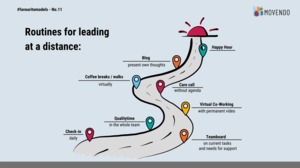#favouritemodel No.11 - Virtual Leadership

Already in face-to-face working contexts, questions such as "How do we work together in a good, motivated, meaningful, goal-oriented and value-adding way?" Concern leaders and teams. This challenge is extended in the virtual context by the fact that we have far less to no chance encounters and far fewer opportunities for interaction.
Accordingly, in the virtual context, it is absolutely critical to use the few interactions deliberately and, even more, to bring them about and shape them intentionally.
Virtual leadership is about consciously designing the framework for successful (collaborative) work and using the possibilities of virtual interaction for this purpose. At what point do we communicate asynchronously and exclusively via email, when do we communicate asynchronously and inclusively via chat function in a collaboration environment, which topics are addressed with each other in video conferences, how do we create "agenda-free" exchange with each other and how do we ensure that all emotional states in the team get their space and no one is left behind in virtual nirvana or the home office. Along with the much-praised efficiency of virtual working, the human need for closeness, contact and relationship must also be brought into balance and trust as the basis of successful team performance must be established and maintained through virtual interactions.
There are many options for shaping virtual leadership and, as always, there is no silver bullet. The decisive factor is to actively and consciously shape leadership and to constantly ask oneself and the team what is needed in order to take the next step as a team in the best possible way. If I understand leadership as a function in my team that should ultimately be independent of me as a leader, then in the virtual context the crucial question is how does leadership remain effective when we are not in virtual meetings? How do we ensure that we have common premises and make decisions according to transparent principles so that they are reproducible for all?
With this understanding of virtual leadership, I design my everyday leadership in such a way that we have as many interactions in the team as possible that always contribute to our building relationships and deal quite explicitly with our different emotional sensitivities - the more, the more transparent, the more explicit, the more diverse relationship building becomes possible. So, what messages will you send today in order to make your contribution to relationship building?
How does my #favouritemodel help you?
Your daily routine in virtual leadership may include the following elements:
- In the morning, post a short message for your team about how you are doing, what's on your mind and how you are available today, so that it is transparent what you are doing and the team is encouraged to share likewise.
- If you have free time, call the team member you haven't spoken to alone for a long time and simply say: How are you? I just want to talk to you again....
- Make sure that you can spend time together as a team on a regular basis. To do this, clarify what is the best time and keep up this exchange without making it a constraint.
- If team members disappear, stay quiet or are not virtually visible, then contact these team members promptly, ask them about it and at the same time make it clear how important the interaction is for the whole team.
- Consider very consciously which possibilities you have and use to convey sufficient appreciation even virtually and to generate pride in the joint achievement. Use these opportunities more often than is usual in a face-to-face culture.
- Regularly provide a deeper insight into your thoughts, feelings and decisions by writing a blog, posting videos or otherwise providing access to what moves you, at least internally and perhaps also externally.
- Regularly clarify with your team what exactly you still need in your virtual interactions to maintain trust and closeness at a distance.











